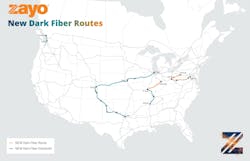The State of Nevada has tasked Zayo to build, operate, maintain, and commercialize the state’s new Middle Mile Network project. This project will bring service to communities with few network connectivity options.
Zayo is tasked with building 800 miles of the open-access fiber network, backed by funding from the National Telecommunications and Information Administration (NTIA) and the Office of Science, Innovation, and Technology (OSIT), to provide robust broadband access to unserved and underserved communities.
Middle-mile infrastructure is fiber-based broadband infrastructure that traverses major Interstate and US Highways in a state. Zayo’s network infrastructure in Nevada passes through rural population centers and areas, terminating in cities like Las Vegas and Reno.
Zayo has tapped Tilson to engineer and deploy the middle-mile fiber network across Route I-80 and down Route US 93, which will span expansive rural communities throughout Nevada.
These areas encompass high rates of unserved and underserved households, businesses, schools, and other critical community facilities needing broadband access. Construction will begin in 2025, and Tilson will continue to expand beyond its existing footprint in Las Vegas, with over 300 employees working on a significant fiber-to-the-home (FTTH) construction project.
The network, which will have two routes through Reno and Las Vegas, will enable connectivity for 40,000 underserved locations, including households, schools, libraries, and community buildings:
· US 93 Route through Las Vegas: This network build will include a $43.5 million investment from the NTIA Middle Mile Grant Program and $43.5 million funded by the Nevada Department of Transportation.
· I-80 Route through Reno: This route includes a $66 million funded by the Department of Treasury Capital Project Funds and the State of Nevada.
Bill Long, Zayo's chief product and strategy officer, said the company's “work in the Nevada Middle-Mile project will help bridge the digital divide in these underserved areas.”
He likens the middle mile to being like the nation’s highway interstate system that can connect the last mile networks.
“To have the Interstate to serve the local communities, you need to have off-ramps,” Long said. “So you need to have an exit off that Interstate that then goes and serves the local communities, and that's the middle mile.”
As the federal government has been advancing the Broadband Equity, Access, and Deployment (BEAD) program, Zayo has been a critical advocate of funding for middle-mile networks. The initial momentum has been focused on financing last-mile connectivity to homes and businesses, but Long emphasized the role of the middle mile.
“A lot of the BEAD funding and other funding coming out of the government is focused on the last mile,” he said. “But if you don't solve for the middle mile, it's a bridge to nowhere.”
Revenue sharing, AI possibilities
Network capacity is only one part of Zayo’s middle mile initiative.
The service provider said its public-private partnership with the State of Nevada will enable “unique revenue-sharing opportunities.”
Zayo can operate, maintain, and commercialize the route to ensure the project's long-term sustainability and economic viability.
Also, as Reno and Las Vegas have become major data center AI centers, the network infrastructure will provide the necessary fiber connectivity to support current and future needs.
Zayo is seeing greater demand for data centers and enabling manufacturing facilities that need network connectivity in smaller markets.
“Historically, a lot of our demand had been in Tier 1 metros,” he said. “We are seeing a huge increase in demand, not only for data centers but to provide connectivity to automotive factories, chip fabs, solar farms, and wind farms with very high bandwidth needs in Tier 2 and Tier 3 markets.”
Network options are limited in areas like West Texas or Southern Indiana, but Zayo’s network is close to those locations.
“It’s been an interesting sort of evolution that our long haul network, the long haul fiber network, is becoming a key strategic asset,” Long said.
Zayo wants to use its work with Nevada to pursue agreements like other states. The provider said this agreement “sets a precedent for other states with similar connectivity needs.”
The service provider’s work with Nevada reflects its work developing new middle-mile networks. Previously, it was awarded $92.9 million as part of the National Telecommunications and Information Administration (NTIA) Middle Mile Grant Program.
Zayo is using the funding build middle mile networks in several states to support education, telemedicine, and public safety communication. Some key middle mile routes include Oregon – California – Nevada, El Paso to Dallas, and Dallas to Atlanta.
Middle mile builds have been a critical priority for Zayo. Since 2018, the service provider has built and operated over 4,000 new route miles of long-haul fiber routes across 17 states.
While he could not name them yet, Long said there are “four other specific states that we're working on a similar program, but what it helps is you need someone progressive like Nevada.”
Lowering rural barriers
Zayo will build the new middle mile fiber routes with its Digital Equity Access Network (DEAN) architecture.
The DEAN architecture enhances rural connectivity by lowering the barrier to entry for rural ISPs to build last-mile infrastructure. It provides pre-provisioned, dedicated fiber backhaul and competitive IP pricing that matches metro market rates.
With multiple interconnection points pre-built into the network, Zayo said it is “making connecting to our middle mile more affordable for ISPs.”
The ISPs that Zayo is working with are not large providers like Comcast or AT&T but smaller telcos or wireless ISPs (WISPs) that need wholesale backhaul connectivity for their networks. These smaller providers typically lack the workforce or bargaining power to get affordable wholesale rates.
Through the DEAN program, help a local ISP define a network architecture.
“These are very small regional operators that are just trying to run their network and don't know how to apply for BEAD funding,” Long said. “You can go to a local ISP and be like, here's how you need to design your network to effectively implement these middle mile solutions tied to your to your last mile networks.”
Zayo’s DEAN program also addresses pricing. A rural ISP buying wholesale services from a Tier 1 carrier is typically more expensive. Zayo’s program also offers middle-mile wholesale pricing to rural providers in large metro areas.
“From a commercial standpoint, we've wrapped this around the funding that we're getting from different entities to be able to offer the economics as if they were buying these services in a dense metro area but making them available in the rural locations,” Long said. “Historically, it's been much more expensive in these rural areas to purchase wholesale internet access because it’s hard to get to versus in a major metropolitan area, which creates friction for people in these rural areas.”
Besides offering more competitively priced wholesale rates, Zayo is also helping rural ISPs in Nevada and other states how to apply for BEAD funding. “We've set up a process on how to train those local ISPs to go after these dollars,” Long said.
Education as an anchor tenant
As Zayo builds its middle mile infrastructure across more states, the service provider has enhanced its ability to serve more school districts.
Through its acquisition of Education Networks of America (ENA) in 2021, Zayo became the largest independent provider of K-12 E-rate services, connecting almost 20,000 schools in the U.S.
Long said, “ENA acquisition allowed us to have the higher level services to serve those schools.”
School districts support their network needs via the E-Rate program—a segment the provider has used to establish an anchor tenant in markets.
“As we connect the schools, we're building the network so that we can also attach businesses and last-mile fiber to home operators and others,” Long said. “So, 20 to 25% of the schools in the US use Zayo service to service those schools, whether it's the Internet access there or the fiber serving them.”
He added that the networks it builds for schools have a rippling effect in those communities.
“The network asset we're building that serves the schools benefits the rest of the community around those schools,” Long said. “It’s good government public policy of helping to put infrastructure in the ground to benefit schools specifically but also benefit the community around them a big part of what we're doing, and you're going to see us play pretty heavily in that space going forward.”
Driving workforce training
Besides offering more excellent bandwidth capabilities, Zayo is also using its knowledge of building fiber networks to help create a next-generation workforce in the communities it serves.
It is working with local ISPs that connect to its middle mile network by helping to develop scholarships for workforce development and fiber technician training.
“You have to connect to fibers, and so we're including a scholarship for fiber text to get training on that,” Long said. “So, it's a holistic program on how to make these local ISPs as successful as possible.”
Zayo has, in effect, created a fiber tech certification program. Offered online, the program can focus on areas where it is building its network.
“If you take someone who's already a sort of a telecom expert or someone who has networking experience, they can take this class that’s associated with some other local trade school,” Long said.
For related articles, visit the Business Topic Center.
For more information on high-speed transmission systems and suppliers, visit the Lightwave Buyer’s Guide.
To stay abreast of fiber network deployments, subscribe to Lightwave’s Service Providers and Datacom/Data Center newsletters.
NTIA’s middle mile push
Momentum around providers building new fiber-based middle mile networks continues to grow.
The Middle Mile grant program, part of President Biden’s “Internet for All” initiative, provides $1 billion in funding to projects that connect high-speed Internet networks and reduce the cost of bringing Internet service to communities that lack it.
In June 2023, the NTIA awarded $930 million to expand middle-mile high-speed Internet infrastructure across 35 states and Puerto Rico as part of President Biden’s Investing in America agenda. Zayo and Hawaiian Telcom were the biggest winners. Zayo will receive $92.8 million of the $930 million awarded through the program for three separate projects touching eight states. Hawaiian Telcom won over $37 million in funding.
According to an NTIA press release, the agency received over 260 applications requesting nearly $7.5 billion in funding. The projects will deploy over 12,000 miles of new fiber within 1,000 feet of 6,961 community anchor institutions. The 32 program winners will invest more than $848 million in additional funding for construction costs.
Providers step into the middle mile
A growing group of traditional service providers, community groups and electric cooperatives have been stepping up to the middle mile plate:
C-Spire: The competitive fiber provider won a $26.2 million NTIA middle mile grant that will enable it to expand its existing network in Birmingham across the southern area of Alabama.
Diamond State Network: This coalition of 13 member-owned electric cooperatives, with over 50,000 miles of fiber, covers 64 percent of Arkansas.
Accord Network: A coalition of 21 electric and telephone cooperatives with over 20,000 miles of fiber covers 75 percent of Indiana.
GOLDENSTATENET: A 10,000-mile broadband network providing middle-mile broadband infrastructure to enable last-mile network connectivity throughout California.
Hoosiers Network: A consortium of 17 ISPs provides services across Indiana.
MassBroadband 123: An open access, fiber middle mile network in western and north central Massachusetts that stretches across over 120 western and central Massachusetts communities.
Zayo: The company is slated to receive $92.8 million through the NTIA’s middle mile program for three separate middle mile projects touching eight states.
About the Author
Sean Buckley
Sean is responsible for establishing and executing the editorial strategy of Lightwave across its website, email newsletters, events, and other information products.



